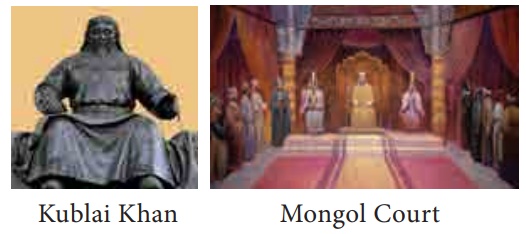East Asia in the Middle Ages | History - China: TŌĆÖang Dynasty (618ŌĆō907 A.D. (C.E.)) | 9th Social Science : History: The Middle Ages
Chapter: 9th Social Science : History: The Middle Ages
China: TŌĆÖang Dynasty (618ŌĆō907 A.D. (C.E.))
EAST ASIA IN THE MIDDLE AGES
China: TŌĆÖang Dynasty
(618ŌĆō907 A.D. (C.E.))
Sui dynasty collapsed in
forty years because of financial burden imposed by public works like the Grand
Canal and the expensive wars waged to conquer northern part of Korea. The TŌĆÖang
dynasty rose from the widespread rebellions that took place to establish a
strong centralised empire. Li Yuan who organised the rebellion made Yang You
the emperor of China. As Yang was killed by one of his royal officials, the
Chancellor, Li Yuan proclaimed himself emperor. Several hundred kilometres of
the Great Wall were rebuilt along the north-west frontiers. Military campaigns
extended the empireŌĆÖs influence into Korea in the east and as far as the
borders of Persia and Indo-China in the west.
Tang dynasty undertook
enormous public works. Two capital cities, Boyang and Chang-on, were built.
Scholar officials, trained in Confucius Philosophy, were appointed to
counterbalance the landowning aristocratic class. Land was divided into small
peasant holdings. As a result, the agricultural surplus went to the state as
taxes, not to the aristocrats as rents. State monopoly of salt, and tea added
to its revenues. However, the mutiny by a frontier general An Lu-shan, led to
years of turmoil. The imperial authority was very much reduced during this
period, as power passed to the provinces.
Great Wall of China:
Between 8th and 7th centuries B.C. (BCE), the warring states in China built
defensive walls to protect themselves from enemies from the north. During Chin
(Qin) Dynasty, the separate walls were connected and consequently the wall
stretched from east to west for about 5000 kilometres. This wall, considered to
be one of the wonders of the world, served to keep nomadic tribes out. The Wall
was further extended and strengthened by the succeeding dynasties. Now it is
6,700 kilometres in length.

Sung Dynasty (960ŌĆō1279 A.D. (C.E.))
The rebellion of
hard-pressed peasantry under the leadership of Hung ChŌĆÖao dealt a death knell
to the tottering Tang empire. The empire split into five rival states, until it
was reunited under a new dynasty, Sung. Trade and industry flourished during
the reign of Sung dynasty. Iron and steel industries became highly organized.
The quantity of iron
China produced in 1078 A.D. (C.E.) exceeded 114,000 tons (England
produced only 68,000 tons even in 1788). China excelled in ceramics and
porcelain-making. This technique was not known to Europe for another 700 years.
Gun powder was in use by 1044. China possessed printed books half a millennium
before Europe. (Chris Harman, A PeopleŌĆÖs History of the World, p. 111.)

Fall of Sung Dynasty
Sung period was also a
period of great prosperity to the landowning class, officials and rich
merchants. The peasants, by contrast, had to suffer grinding poverty. Before
any internal crisis could develop, there were two external invasions from the
north that ended the Sung dynasty. The Mongols established their rule in the
name of Yuan dynasty.
Yuan Dynasty (1279ŌĆō1368 A.D. (C.E.))
The Mongols, who overran
Persia and the whole of Central Asia, did not spare China either. Mangu Khan
became the Great Khan in 1252 who appointed Kublai Khan the Governor of China.
The Mongol presence from one end of Eurasia to the other played a key role in
spreading Chinese technological advances to the less developed societies in the
west. Though the Mongol court in Beijing impressed a foreigner like Marco Polo,
the poverty of peasantry continued. There were revolts of religious sects and
secret societies. Finally, the leader of ŌĆ£Red TurbansŌĆØ Chu Yuan Chang
took the Mongol capital Beijing and proclaimed himself emperor in 1369.

Ming Empire (1368ŌĆō1644 A.D.(C.E.))
The Ming Empire, which
replaced the Mongol empire, consciously discouraged industry and foreign trade
in order to concentrate on agriculture. This resulted in China lagging behind
in the 16th century. Other parts of Eurasia, building on the techniques of the
Chinese, began to march ahead.
Related Topics